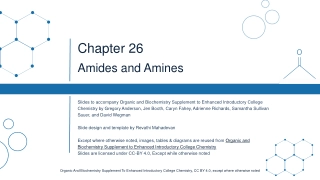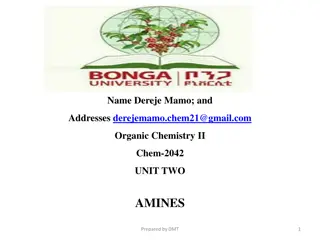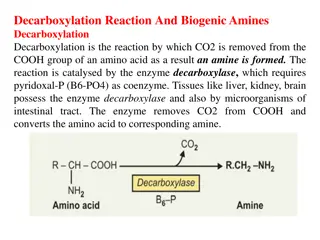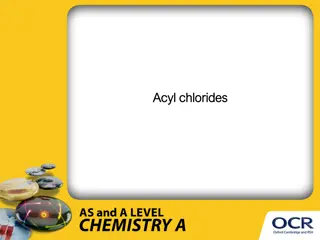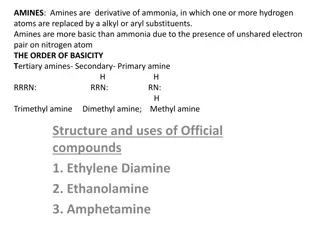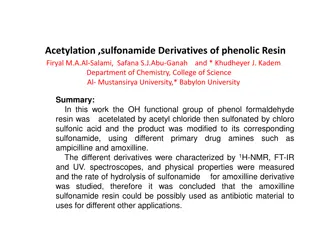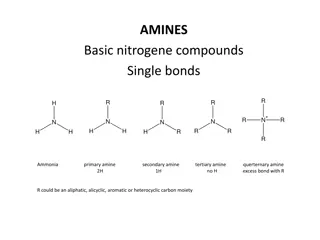
Understanding Amines: Structure, Classification, Nomenclature, and More
Delve into the world of amines, organic derivatives of ammonia with various biological activities, used in drugs and medicines. Learn about their structure, classification, nomenclature, and properties, including common and IUPAC names for different types of amines. Explore the diverse applications and naming conventions in the realm of amines.
Download Presentation

Please find below an Image/Link to download the presentation.
The content on the website is provided AS IS for your information and personal use only. It may not be sold, licensed, or shared on other websites without obtaining consent from the author. If you encounter any issues during the download, it is possible that the publisher has removed the file from their server.
You are allowed to download the files provided on this website for personal or commercial use, subject to the condition that they are used lawfully. All files are the property of their respective owners.
The content on the website is provided AS IS for your information and personal use only. It may not be sold, licensed, or shared on other websites without obtaining consent from the author.
E N D
Presentation Transcript
241 Chem CH-8 Amines 1
Learning Objectives By the end of this chapter the student will know: Structure and Classification of amines Nomenclature of amines Physical Properties of amines Preparation of amines Reaction of amines 2
Structure and Classification of Amines Amines are organic derivatives of ammonia in which one or more hydrogens are replaced with alkyl or aryl groups. It has high degree of biological activity, many amines are used as drugs and medicines. Amines are classified as primary, secondary, or tertiary, depending on the number of carbon atoms bonded directly to nitrogen. In a heterocyclic amine, the nitrogen atom is part of an aliphatic or aromatic ring. 3
Nomenclature of Amines Common names are formed from the names of the alkyl groups bonded to nitrogen, followed by the suffix -amine. The prefixes di-, tri-, and tetra- are used to describe two, three, or four identical substituents. The IUPAC system, the amino group, -NH2, is named as a substituent. In this system, secondary or tertiary amines are named by using a prefix that includes all but the longest carbon chain. Recently, Chemical Abstracts (CA) introduced a system for naming amines that is rational and easy to use. In this system, amines are named as alkanamines, the -e ending in the alkane name is changed to -amine,and a number shows the position of the amino group along the chain. Other substituents on the carbon chain are given numbers, and the prefix N- is used for each substituent on nitrogen. 4
aminoethane ethanamine ethylamine 2-aminopentane 2-pentanamine sec-butylamine IUPAC name: Common name: aminocyclohexane cyclohexanamine cyclohexylamine cis-1,3-diaminocyclobutane cis-cyclobutane-1,3-diamine 1,3-cyclohexyldiamine 1-(ethylamino)ethane N-ethylethanamine diethylamine 1-(diethylamino)ethane N,N-diethylethanamine triethylamine 1-(methylamino)propane N-methyl-1-propanamine methylpropylamine 1-(ethylmethylamino)propane N-ethyl-N-methyl-1-propanamine Ethylmethylpropylamine 2-(methylamino)ethanol 2-(N-methylamino)ethanol 1-amino-3-pentanone 3-aminobutanoic acid 1-(dimethylamino)cyclohexane N,N-dimethylcyclohexanamine cyclohexyldimethylamine 5
Nomenclature of Amines Aromatic amines are named as derivatives of aniline. In the CA system, aniline is called benzenamine; these CA names are shown in parentheses. Aniline benzenamine 4-methoxyaniline p-Anisidine 4-bromoaniline p-bromoaniline 4-methylaniline p-Toluidine N-Methylaniline N,N-dimethylaniline N-methyl-3-methylaniline N-methyl-m-toluidine 6
Physical Properties of Amines Solubility All three classes of amines can form hydrogen bonds with the -OH group of water (that is, O-H N). Primary and secondary amines can also form hydrogen bonds with the oxygen atom in water: N-H O. Thus, most simple amines with up to five or six carbon atoms are either completely or appreciably soluble in water. Boiling point Amines are moderately polar substances; they boil well above alkanes with comparable molecular weights, but below comparable alcohols. Intermolecular N-H N hydrogen bonds are important and raise the boiling points of primary and secondary amines but are not as strong as the O-H O bonds of alcohols. The reason for this is that nitrogen is not as electronegative as oxygen. Molecules of tertiary amines cannot form hydrogen bonds to each other, as a result, tertiary amines generally boil at lower temperatures than primary and secondary amines of comparable molecular weight. 7
Physical Properties of Amines Basicity of Amines: Amine Salts The unshared pair of electrons on the nitrogen atom dominates the chemistry of amines. Because of this electron pair, amines are both basic and nucleophilic. Aqueous solutions of amines are basic because of the following equilibrium: Amines are relatively weak bases. Most are stronger bases than water but are far weaker bases than hydroxide ions, alkoxide ions, and alkanide anions. Alkylamines are approximately 10 times as basic as ammonia. Recall that alkyl groups are electron-donating relative to hydrogen. Aromatic amines less basic than aliphatic amines. Electron-donating groups increase the basicity of amines, and electron-withdrawing groups decrease their basicity. NH2 NH2 NH2 NH2 > > > 8 CH3 NO2
Preparation of Amines 1- Alkylation of Ammonia and amines : Nucleophilic Substitution Reaction (SN2) Primary, secondary, and tertiary amines can be similarly alkylated. 2- Reduction of nitro compounds 9
Preparation of Amines 3- Reduction of Nitriles 4- Hydride Reduction of Amides 10
Preparation of Amines 5- Reductive Amination of Aldehydes and Ketones 6- Preparation of Primary Amines through the Hofmann degradation 11 Aniline
Reactions of Amines 1- Reaction of Amines with Strong Acids; Amine Salts Amines react with strong acids to form alkylammonium salts 2- Alkylation of Amines: Quaternary Ammonium Salts (Amines as Nucleophiles) 12
Reactions of Amines 3- Acylation of Amines with Acid Derivatives (Amines as Nucleophiles) They react with the carbonyl group of carboxylic acid derivatives (acyl halides, anhydrides, and esters) by nucleophilic acyl substitution. 13
Reactions of Amines 4- Reactions with Nitrous Acid Primary aliphatic amines react with nitrous acid through a reaction called diazotization to yield highly unstable aliphatic diazonium salt. 14
Reactions of Amines 4- Reactions with Nitrous Acid Secondary amines react with nitrous acid to yield N-nitrosoamines. Tertiary aliphatic amine react with nitrous acid to form the tertiary amine salt and N-nitrosoammonium compound. Tertiary arylamines react with nitrous acid to form C-nitroso aromatic compounds. 15
Reactions of Amines 5- Syntheses Using Diazonium Salts Diazo Coupling; Azo Dyes 16

